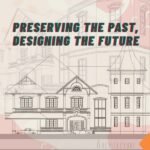Architects need to stay updated with the current trends in architecture to create designs for the future. These designs are often influenced by changing societal needs, new technologies, and emerging global challenges. The spaces architects create should be both functional and aesthetically pleasing.
Their designs should address the changing needs of the community by addressing real-world problems. In this blog, we discuss how future architects can adapt to the changing trends in courses for architecture engineering to meet the opportunities and challenges in a rapidly changing world.
Also read: Developing Design Concepts in Architecture
Understanding the Bachelor of Architecture: Foundation of Modern Design
What is a Bachelor of Architecture?
A Bachelor of Architecture (B.Arch) is an undergraduate degree program spanning five years. This course, combining practical and theoretical knowledge, prepares students for different careers in architecture.
B.Arch focuses on the planning, designing and construction of physical structures. The program aims to impart a thorough understanding of the basic principles of architecture. It also helps in developing the creativity and problem-solving skills of students.
A course for architecture is significant as it equips students with the skills and knowledge to design and create different spaces. These spaces will not only be aesthetically pleasing but also functional. They would also contribute to the comfort and welfare of society and individuals.
The course bridges the gap between science, technology, and the arts. It also allows students to shape spaces that leave a tangible impact on the world.
An architecture graduation also serves as a stepping stone in the architecture field in different ways:
- It prepares graduates for entry-level positions such as junior designers, CAD (computer-aided design) operators, and architectural technicians.
- It allows students to explore specializations such as sustainable design, urban planning, and historic preservation.
- Prepares graduates for Master of Architecture (M.Arch) and other advanced degrees.
- The program develops students’ transferable skills such as problem-solving, logical thinking, and communication.
- Prepares students for professional development with opportunities for research, continuing education, and training.
- The graduation program opens unconventional career paths, such as in interior design and landscape architecture
Also read: Why You Choose Architecture as a Career Choice in 2025?
Emerging Trends in Courses for Architecture Engineering
The latest trends in courses for architecture engineering emphasize sustainability, digital technologies, and interdisciplinary approaches. Sustainability has become a core principle of these courses. The curricula of these courses integrate concepts such as green building, sustainable design, and environmental stewardship.
Architecture engineering courses increasingly incorporate parametric design and digital modeling. It also incorporates fabrication techniques like 3D printing. Interdisciplinary collaboration between students and professionals from fields like engineering and urban planning is another emerging trend in architecture courses.
The drive for environmentally conscious and innovative building practices makes sustainable design and digital fabrication the key current trends in architecture. Sustainable designs cut the adverse effects of buildings on the environment throughout their lifecycle.
Advanced technologies such as CNC machines and 3D printing are used in digital fabrication. These technologies help create customized, more precise, and sustainable designs.
The trend of interdisciplinary approaches in architecture degree courses prepares students to tackle the complexities in the built environment by collaborating with professionals from other fields. The following are some of the significant benefits of interdisciplinary architecture education:
- Development of a wider range of skills
- More comprehensive and innovative design solutions
- Creative solutions for complex challenges
- Better preparedness to meet the real-world demands in the profession
Duration and Structure: Adapting to New Learning Models
Architecture degree courses are evolving to address industry demands and to incorporate learning methodologies. These courses emphasize sustainability, integrate technology, and become more multidisciplinary.
The following are a few ways in which these courses are adapting to new learning methodologies:
- The duration of architecture courses like the accelerated B. Arch is shorter compared to traditional programs. Yet, these are more intensive programs prioritizing skills and knowledge for immediate practice.
- Many schools encourage interdisciplinary collaboration and transdisciplinary projects. They are also offering flexibility in learning with an online and a hybrid model of learning.
- New architecture courses focus on technologies such as digital design tools, Building Information Modeling (BIM), and 3D printing and fabrication.
- These courses follow the industry-relevant curriculum, focusing on emerging industry trends. Such a curriculum prepares students to face global challenges. It also encourages students to engage in lifelong learning.
Integrating Technology: The Digital Transformation in Architecture Education
Technology integration is one of the significant current trends in architecture. The usage of tools like augmented reality/virtual reality (AR/VR), building information modeling (BIM), and artificial intelligence (AI) is reshaping the learning experiences in B.Arch.
These tools allow for visualizing designs, managing projects, and collaborating with clients innovatively. Thus, technology integration trends in courses for architecture engineering are leading to more innovative and efficient architectural practices.
BIM improves architecture education by
- Enabling students to generate intricate 3D models of buildings.
- Improving interdisciplinary coordination and communication
- Facilitating better project delivery
- Helping students develop more sustainable designs for buildings
The following are the impacts of AR/VR on the architecture learning process:
- Students can experience designs in a virtual environment.
- Clients can explore designs through a virtual tour.
- Students can explore spatial relationships in different design concepts.
- Workers get real-time guidance by overlaying digital information onto the actual construction site.
Artificial intelligence contributes to the evolving field of architecture through:
- Optimizing design choices after analyzing design data
- Automating different tasks, such as generating reports and creating design variations
- Analyzing large datasets to create more efficient designs
- Personalizing learning experiences for students.
Global Perspectives: International Influences on Architecture Curriculum
Globally, smart buildings, sustainability, modular construction, and adaptive reuse are some of the current trends in architecture. These trends lead to curriculum updates in the local architecture degree courses. They now focus on technological advancements and interdisciplinary collaboration.
Global architecture trends influence local education in architecture in the following ways:
- Students learn about energy-efficient systems, green building strategies, and eco-friendly materials.
- Creation of smart buildings with technology integration into building design
- Students learn sustainable strategies for repurposing existing buildings.
- Students learn about sustainable, efficient, and cost-effective construction methods as part of modular construction techniques.
- International collaboration exposes students to diverse design practices and philosophies from around the world.
- Local courses are taking an interdisciplinary approach to give students a comprehensive understanding of the built environment.
- Students use BIM, AR/VR, and other digital tools to experience and visualize designs effectively.
Also read: 5 Design Philosophies in Vogue
TKMSA’s Approach: Embracing and Leading Educational Trends
TKM School of Architecture integrates new trends in courses for architecture engineering by focusing its curriculum and pedagogy on interdisciplinary learning and technology. Students are equipped with advanced software tools.
Students at TKMSA are encouraged to promote sustainability in design and take part in interdisciplinary collaboration. The school addresses the opportunities and challenges in architecture and prepares graduates for the evolving architectural profession.
TKM School of Architecture offers a course for architecture by integrating the following trends:
- Technology Integration:
The school equips students with skills and advanced software tools to enhance design processes.
- Sustainability in Design:
The school supports environmentally conscious practices in architecture. It encourages students to incorporate sustainable principles in their designs in their projects.
- Interdisciplinary Learning:
TKMSA promotes a holistic understanding of architectural solutions and challenges among its students. Hence, its curriculum encourages learning and collaboration across different disciplines.
- Meeting the Challenges in the Architectural Profession:
The school prepares students for the evolving and dynamic architectural profession. It accomplishes this by laying emphasis on interdisciplinary learning, sustainability, and technology.
Preparing for the Future: Skills and Competencies for Tomorrow’s Architects
An architecture graduation equips students with a blend of transferable knowledge, technical skills, and creative abilities. These skills ready students for diverse career paths.
Modern architecture degree courses focus on the development of both technical and soft skills and competencies. These degree courses prepare students to pursue a successful professional life in architecture.
The following are some of the key skills and competencies that modern architecture degree courses strive to develop in students:
- Design and Technical Skills:
- Creativity and Design Flair:
- Technical Proficiency:
- Design Skills:
- Analytical Skills
- Problem-solving
- Visualization Skills
- Soft Skills and Competencies:
- Communication:
- Teamwork and Collaboration:
- Critical Thinking
- Prioritization and Time Management
- Adaptability and Flexibility
- Attention to Detail
- Problem-solving
- User-Centric Mindset with Empathy
- Ethical and Sustainable Methods
- Other Important Skills:
- Knowledge in business and marketing.
- Knowledge of building codes and regulations
- Interpersonal Skills
- Leadership Skills
- Continuous Learning
- Professional Development
Conclusion: Navigating the Future of Architecture Education
Staying abreast of educational trends in courses for architecture engineering is crucial for both professionals and students. They thrive in the dynamic field by adapting to new design approaches, technologies, and industry needs.
TKM School of Architecture stays abreast of current trends in architecture with real-time industry updates through social media. Students from TKMSA actively engage in socially relevant projects.
The school also offers research guidance in architecture, planning, and other areas. With hands-on projects, personalized attention for students, and collaborative learning, the school creates a learning atmosphere that fosters innovation.
Also read: Best Architecture Colleges in Kerala: The Only List You Need in 2025




